|
|
|||
|
(Back to Preceding Week; on to Next Week) |
|
Week One is full and Week Three has only one slot remaining for our annual |
|
HUMMINGBIRD BIRTHDAY Each year at Hilton Pond Center we look forward to the 15th of September for two main reasons. First, it is Independence Day in Costa Rica (flag below right), a country we have come to know and appreciate during our six mid-winter hummingbird expeditions; on 15 September 1821 Costa Rica was declared independent from Spain--a declaration jointly made by several Spanish provinces in Central America.
Birds that return to Hilton Pond Center after banding bring a certain sense of satisfaction--plus an understanding of site fidelity--but real excitement for any bander comes when a local bird shows up elsewhere. Researchers who work with game species such as doves and waterfowl (including the legally harvested Wood Duck hen above) have relatively high percentages of their birds encountered at distant locales, mostly because shooters do a good job of turning in band numbers during hunting season. However, those of us who focus on "dickie birds" such as sparrows and warblers seldom have our birds found away from the banding site, and hummingbird banders have even lower encounter rates. Since 1982 at Hilton Pond we've banded 51,663 birds of 124 species. Literally thousands of these have been recaptured at least once at the Center, with some individuals entering traps or hitting mist nets dozens of times through the years. This has told us a great deal about longevity and site fidelity and a little about breeding behavior and seasonal movements. Our rate of "foreign encounters" is much lower than that of many banders, probably for two reasons: 1) There are few other banders in the Carolinas to recapture and report birds from Hilton Pond Center; and, 2) The human population density within North and South Carolina is relatively low, meaning there's a lot of rural area in which a banded bird can eventually die and disappear, with fewer people to find it when it perishes.
Interestingly, our Ruby-throated Hummingbird encounter rate is right in line with our cumulative total for all species; of the 3,785 RTHU banded at the Center just five have been found dead or recaptured, but that's 0.11%. (We've done quite a bit better on our vagrant Rufous Hummingbirds. Of the two banded locally, 50% have been recaptured elsewhere, with our November rufous showing up in Columbus OH almost exactly a year after banding.)
Anyway, it's a joyous time when the Bird Banding Lab sends us a "Report to Bander" notifying us a bird from Hilton Pond has indeed been encountered elsewhere--even though sometimes a report means the bird has perished. Until this week, we knew two of our ruby-throats had been recaptured and released alive (near Atlanta GA and Mobile AL, respectively; see map above), and two others had been found dead (Thomaston AL and Clover SC). Another color-marked hummer from the Center was sighted in western Louisiana. Our birthday greeting on 15 September this year added one more ruby-throat to our short list of foreign encounters. The report from the Banding Lab (above) contained some interesting info. For one, it included the band number of the ruby-throat in question: 3000-16183. This caught our attention right away because it meant we banded this bird at Hilton Pond Center LAST year on 1 September--as an adult male.
The Banding Lab also provided the name of the finder and--in what has to be the most ironic banding scenario in which we've ever been involved--that person turned out to be Lisa Hylton. We wonder, what ARE the odds of a banded hummingbird from Hilton Pond being found 670 miles north by someone also named HYLTON? Curious about the encounter, we called Lisa and--after thanking her for our 15 September "birthday present"--determined we Hiltons/Hyltons shared a surname but were not closely related. Lisa then told us about the encounter, about how she found the male hummingbird when he--and a second bird--apparently had crashed into a window at her house, perhaps in a territorial dispute or frantic courtship flight. After determining both birds were dead she noticed a band on one of them, reported the number to the Bird Banding Lab, and eventually took both specimens to her local nature center. We appreciate Lisa Hylton's initiative in reporting the number from the hummingbird she found. Researchers undoubtedly lose priceless data because folks who encounter banded birds of any species fail to contact the Banding Lab, so please spread the word about what to do with banded birds. The adult male Ruby-throated Hummingbird Lisa found at Mystic this past May was a spring encounter that occurred after we banded him the preceding fall, so it's very likely this bird was on or near his breeding grounds in Connecticut when he hit the window. All six ruby-throats banded at Hilton Pond and encountered elsewhere were captured during fall migration, but the latest bird is the only one to be found far NORTH of the Center or during spring migration. With the exception of our in-county hummer found ten miles away at Clover SC, the other birds were all encountered SOUTHWEST of York and in autumn migration.
All text & photos © Hilton Pond Center Comments or questions about this week's installment?
Thanks to the following fine folks for recent gifts in support of Hilton Pond Center for Piedmont Natural History and/or Operation RubyThroat: The Hummingbird Project. Your tax-deductible contributions allow us to continue writing, photographing, and sharing "This Week at Hilton Pond." (Please see Support if you'd like to make a gift of your own.)
"This Week at Hilton Pond" is written & photographed You may wish to consult our Index of all nature topics covered since February 2000. You can also use our on-line Hilton Pond Search Engine at the bottom of this page. For a free, non-fattening, on-line subscription to |
|
Make direct donations on-line via
Network for Good: |
|
|
Use your PayPal account
to make direct donations: |
|
|
If you like to shop on-line, you please become a member of iGive, through which more than 700 on-line stores from Barnes & Noble to Lands' End will donate a percentage of your purchase price in support of Hilton Pond Center and Operation RubyThroat. For every new member who signs up and makes an on-line purchase iGive will donate an ADDITIONAL $5 to the Center. Please sign up by going to the iGive Web site; more than 150 members have signed up to help. It's a painless, important way for YOU to support our work in conservation, education, and research. |
|
| The highly coveted Operation RubyThroat T-shirt (four-color silk-screened) is made of top-quality 100% white cotton. It highlights the Operation RubyThroat logo on the front and the project's Web address (www.rubythroat.org) across the back.
Now you can wear this unique shirt AND help support Operation RubyThroat: The Hummingbird Project and Hilton Pond Center. Be sure to let us know your mailing address and adult shirt size: Small (suitable for children), Medium, Large, X-Large, or XX-Large. These quality shirts don't shrink! Price ($26.50) includes $5 U.S. shipping. A major gift of $1,000 gets you two Special Edition T-shirts with "Major Donor" on the sleeve. |
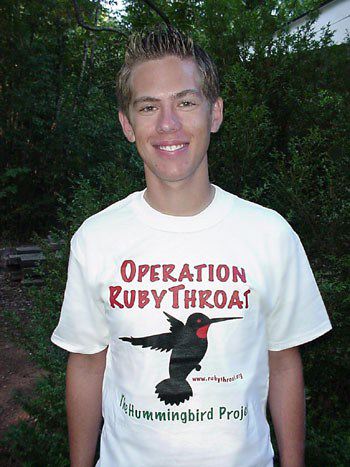
Need a Special Gift for a Want to make a If so, why not use our new handy-dandy on-line Google Checkout below to place your secure credit card order or become a Major Donor today? |
|
|
|
|
SPECIES BANDED THIS WEEK: * = New species for 2008 WEEKLY BANDING TOTAL 18 species 62 individuals YEARLY BANDING TOTAL (2008) 57 species 1,496 individuals 197 Ruby-throated Hummingbirds 27-YEAR BANDING GRAND TOTAL (since 28 June 1982) 124 species 51,663 individuals NOTABLE RECAPTURES THIS WEEK (with original banding date, sex, and current age) 2008 Ruby-throated Hummingbird returns from past years--38 Northern Cardinal (2) Eastern Tufted Titmouse (1) All text & photos © Hilton Pond Center |
OTHER NATURE NOTES OF INTEREST --A significant influx of migrating Ruby-throated Hummingbirds has astounded us this fall after extremely low banding results all spring and summer. In the past seven days we banded 26 new RTHU, bringing the 2008 season total to a surprising 197 birds. All individuals banded this week were juveniles--16 males and ten females. --Other fall migrants also have been moving through, including tanagers, warblers, and the fist juvenile male Rose-breasted Grosbeak of the fall. --We expressed profound relief recntly that water depth in Hilton Pond increased significantly after the 10.6" of precipitation we got from Hurricane Fay. Unfortunately, that was a month ago, and without subsequent downpours water levels are starting to drop again. Some loss is due to evaporation, but we suspect all those herbaceous plants that started growing on exposed mud banks earlier this summer are contributing. Although their roots are submerged, their exposed leaves are giving up a lot of moisture through transpiration. Bottom line is we need some steady winter rains this year to assure that Hilton Pond doesn't start out with a deficit in 2009. --This week's photo essay above talks about numbers of birds banded locally vs. how many have been seen elsewhere. For a list of all 53 birds banded at Hilton Pond Center and encountered outside York County SC, see Foreign Encounters. --Another 26 birds were encountered closer to the Center within our home county. That list is at York County Encounters. |
|
|
|
(Back to Preceding Week; on to Next Week) Up to Top of Page Back to This Week at Hilton Pond Center Current Weather Conditions at Hilton Pond Center |
 You can also post questions for The Piedmont Naturalist |
Join the |
Search Engine for |
|
|
long term relationship

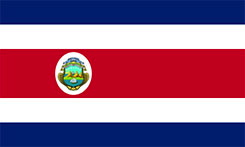 (Costa Rica, however, did not actually declare itself sovereign until 1838.) The mid-September date is also significant locally because it's the birthday of the founder of Hilton Pond Center, who is always happy to receive cards and e-mails from folks who know and remember. Natal date greetings did arrive this year--his 62nd--but the most exciting communication came from the U.S. federal Bird Banding Laboratory (BBL) just outside Washington DC. This week, on 15 September 2008, we got about the best birthday gift imaginable for a bird bander--notification from the BBL that one of our Ruby-throated Hummingbirds banded at Hilton Pond had been encountered somewhere else!
(Costa Rica, however, did not actually declare itself sovereign until 1838.) The mid-September date is also significant locally because it's the birthday of the founder of Hilton Pond Center, who is always happy to receive cards and e-mails from folks who know and remember. Natal date greetings did arrive this year--his 62nd--but the most exciting communication came from the U.S. federal Bird Banding Laboratory (BBL) just outside Washington DC. This week, on 15 September 2008, we got about the best birthday gift imaginable for a bird bander--notification from the BBL that one of our Ruby-throated Hummingbirds banded at Hilton Pond had been encountered somewhere else!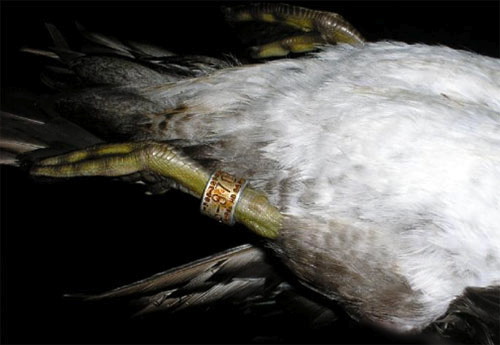
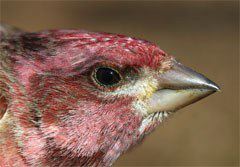 However, of those nearly 52,000 birds, only 53 have been found dead or recaptured and released outside our South Carolina home county of York--a mere 0.1%--so we haven't learned a lot about migration, except for our 15 Purple Finches (left) and 14 House Finches that have shown up across the U.S. and Canada. (Another 26 of our birds from Hilton Pond have been reported within York County, and we've also recaptured seven individuals banded elsewhere by other banders.)
However, of those nearly 52,000 birds, only 53 have been found dead or recaptured and released outside our South Carolina home county of York--a mere 0.1%--so we haven't learned a lot about migration, except for our 15 Purple Finches (left) and 14 House Finches that have shown up across the U.S. and Canada. (Another 26 of our birds from Hilton Pond have been reported within York County, and we've also recaptured seven individuals banded elsewhere by other banders.)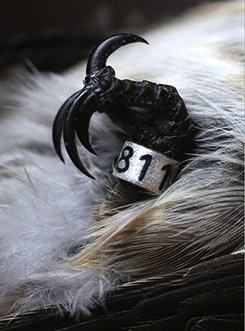 And what about hummingbirds? Between 27 July 1984 and 14 September 2008 we've banded 3,785 Ruby-throated Hummingbirds at the Center, including 171 so far in 2008. Of the 3,614 handled prior to this year, 440 individuals (12.2%) have returned in at least one later year. It's always a pleasure--and a wonderment--to recapture one of these little balls of fluff, knowing it has flown a thousand miles or more one way from York SC to its wintering grounds in the Neotropics and then doubled its frequent flyer miles on the return trip. Most ruby-throats we band we never see again--the difficulty of a first migration probably knocks off the majority of young hummers--but we've had several hatch-year hummers come back as many as five years in a row after banding.
And what about hummingbirds? Between 27 July 1984 and 14 September 2008 we've banded 3,785 Ruby-throated Hummingbirds at the Center, including 171 so far in 2008. Of the 3,614 handled prior to this year, 440 individuals (12.2%) have returned in at least one later year. It's always a pleasure--and a wonderment--to recapture one of these little balls of fluff, knowing it has flown a thousand miles or more one way from York SC to its wintering grounds in the Neotropics and then doubled its frequent flyer miles on the return trip. Most ruby-throats we band we never see again--the difficulty of a first migration probably knocks off the majority of young hummers--but we've had several hatch-year hummers come back as many as five years in a row after banding.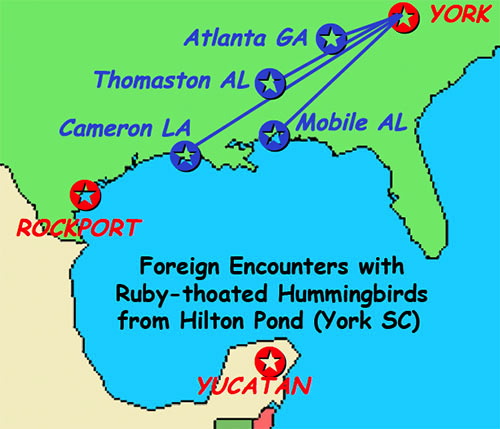

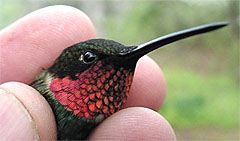 Since it had a full red gorget when captured (example at left), he must have hatched out at least in 2006--meaning he was an "after hatch year" bird at banding time in 2007. The report went on to say the male hummer had been reported by the finder via the Banding Lab's new on-line form, that he had been killed accidentally by "striking a stationary object," and that he had been found on 31 May of THIS year--in Mystic, Connecticut (see map below)--about nine months after banding and by then an "after second year" bird.
Since it had a full red gorget when captured (example at left), he must have hatched out at least in 2006--meaning he was an "after hatch year" bird at banding time in 2007. The report went on to say the male hummer had been reported by the finder via the Banding Lab's new on-line form, that he had been killed accidentally by "striking a stationary object," and that he had been found on 31 May of THIS year--in Mystic, Connecticut (see map below)--about nine months after banding and by then an "after second year" bird.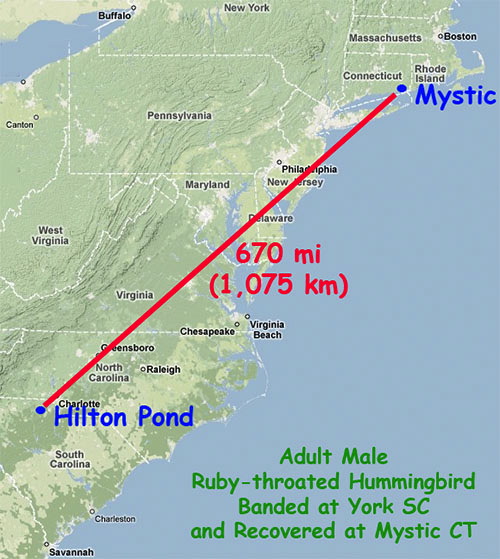
 We'll never know if our "birthday hummingbird" from this year passed through Hilton Pond Center on its way north in the spring of 2008, but it's still very interesting to know a bird banded here in the Carolina Piedmont may have originated so far to the north in Connecticut. Banded hummingbirds are seldom encountered away from their original banding site, but every one that is recaptured or found and reported gives us a better understanding of the migratory movements of these amazing little birds. Thanks, Lisa Hylton, for the 15 September birthday present.
We'll never know if our "birthday hummingbird" from this year passed through Hilton Pond Center on its way north in the spring of 2008, but it's still very interesting to know a bird banded here in the Carolina Piedmont may have originated so far to the north in Connecticut. Banded hummingbirds are seldom encountered away from their original banding site, but every one that is recaptured or found and reported gives us a better understanding of the migratory movements of these amazing little birds. Thanks, Lisa Hylton, for the 15 September birthday present.

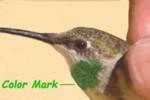 Please report your
Please report your